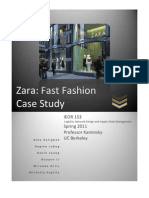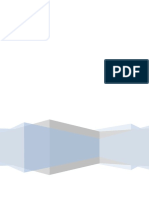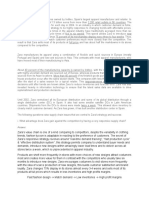Zara Stores v3
Zara Stores v3
Uploaded by
Timothy T CarsonCopyright:
Available Formats
Zara Stores v3
Zara Stores v3
Uploaded by
Timothy T CarsonOriginal Title
Copyright
Available Formats
Share this document
Did you find this document useful?
Is this content inappropriate?
Copyright:
Available Formats
Zara Stores v3
Zara Stores v3
Uploaded by
Timothy T CarsonCopyright:
Available Formats
Zara: Managing Stores for fast fashion
ESI 6323: Models for Supply Chain Management Case Study
Dr. Joseph Geunes OEM Class of 2012
August-13-2011
Prepared by: Tim Carson Khori A. Hunter Annie Malpartida Neville Sicard-Gregory
Introduction
Zara is the largest and most popular brand for retailer corporate group Inditex created by
Spanish entrepreneur Amancio Ortega Gaona. The first Zara store opened in 1975 in Coruna, Spain selling stylish apparel at affordable prices. 10 years later Gaona created the corporate group Inditex, and during the 90s started to expand outside of Spain by acquiring and developing new brands. Inditex went public in 2001 and by 2008 it was an 8 brand group with over 4200 stores, 89,000 employees, and worth 10 billion Euros. Zara was still at the heart of the
companys success and in 2008, there were over 1500 Zara stores operating in 72 countries around the globe and generating 6.8 billion euros in revenue the same year. Zara initiated the concept of fast fashion that could be summarized in mid-quality fashionable products that are manufactured in a fast manner and sold at low prices. Considerable autonomy within stores under an overall corporate control allows best practices while maintaining the Zara culture. In fact Zara was renowned for its responsive supply chains ability to deliver fashionable products to meet changing customer demand. Zaras quick reaction to demand is supported by supply chain oriented to three product lines: womens, mens and childrens. Each of these lines is managed independently from separate regional managers at the country level down to separate section managers within the store. Tremendous autonomy is given to the store managers. This is key as it not only allows for quick decision making, but also allows each store to adapt to it cultural environment, and independent ideas for improvement. At the same time, the corporate offices maintain overall control and ensure consistent presentation across all its stores. Suppliers located in Europe, America, and Asia ship all products, regardless of origin or destination, to logistics centers in Spain for further distribution to stores worldwide. Two
logistics centers in Spain manage all merchandise for the Womens and Mens line, while a single separate center managed the entire childrens line. Close proximity to suppliers with short lead times allow Zara to deliver new fashions quickly. This is important for its high fashion line with unpredictable demand. Suppliers with longer lead times manufacture the basic products since forecast is more predictable and costs are lower. Stores in Europe receive their deliveries within 24 hours while their counterparts in Asia and Americas expect their orders within 40
hours; however, deliveries almost never match the order due to limited inventory in logistic centers.
Problem context
Although the company is very successful, it does have some opportunities for improvement.
As explained before Zara is known for is fast delivery of highly fashionable clothes.
Its
competition has about a six month window from production to storefront; Zara does the same in less than three weeks. This allows them to produce around 11,000 items in a season compared to 2,000 4,000 by its competitors. Faster moving items are produced utilizing nearby suppliers with short lead times and shipped all over the world by air. This method of transportation represents about one percent of an items selling price. Slower moving basic items use cheaper suppliers with longer lead times and cheaper methods of transportation. Regardless of final destination, all products move through a logistics center in Spain before being shipped to its final store destination. This means that if an item is produced in Asia and is also needed by a store in Asia, that item will be transported to Spain first and then back by air to Asia. Zara manufactures 49% of its own products and this number is growing. By owning its own production Zara can be flexible with variety, amount, how often and the various styles they produce. Another key component to Zaras manufacturing is that much of it is done through season. Most traditional retailers manufacture products just several times a year. Since Zara is constantly producing new and updated designs they are in affect purposely creating a rapid product turnover. This in turn produces a climate of scarcity in Zara stores in which the consumer feel they are getting a piece of clothing that is not only fashionable but one in which they know they will not run into anybody wearing the same outfit they just bought. The climate also ensures consumers visit the stores to buy products again and again. In addition, Zaras scarcity climate allows the company to sell more items at full price. Zaras managers and sales associates play a large role in communicating sales information, store trends and product cycles to the designers and managers in the corporate office. This practice has allowed the company to consistently meet customer demand with fashionable and trendy products. Zara has no IT system to help them with store-inventory data. Instead section
managers knew the inventory of their stores through spending time on the selling floor. Although every store receives inventory relatively quickly, they never received exactly what they ordered. It will be really challenging to calculate the precise amount of lost sales due to unavailability of items at logistic centers for orders that were not fulfilled. Fashionable and new products forecasts have more variability than basic items especially when they become really successful. Hence, it seems that the suppliers for non-basic items, located in Europe, are not reacting fast enough to changes in demand immediately perceived by stores. Zara has an amazingly successful business model that is different from any traditional retailer. However, Zaras disadvantages are also different from a traditional retailer. Zara recently consolidated transportation across the different brands. With all of the products being delivered through just one of two distribution centers in Spain, Zara is captive to any disruptions in that region. This leaves them no way to circumvent any unforeseen issues that could disrupt the flow of products to its stores. This also means that Zaras supply chain cost is tied to the Euro and this leaves them extremely susceptible to any financial vulnerabilities that are created as the Euro strengthens or weakens Additionally, the logistics of the physical inventory receipt at the store proves to be an ongoing issue as well. Products are frequently shipped on the wrong hangers, plastic around each item, and the same item may show up in multiple boxes. This makes it an extremely time consuming task to unpack, group, and put merchandize out on display before customers arrive. Zara also has a policy that requires stores not to display items unless all sizes were available for display. If all sizes are not available, the entire line is put in the backroom until all sizes are available. With high fashion items moving fast, and deliveries being in accurate, a set of items could be stored in the backroom for quite some time, which could lead to lost sales for those items. It has become evident that most of the sales associates work was managing in store logistics as opposed to selling products. Inditex as a whole has the need to improve efficiencies throughout the organization. Although they have suffered less of an impact during the recession than its competitors, it has noticed its growth has slowed down.
Analysis and Recommendations
By the end of 2008, 22% of the stores were not located in Europe including 173 stores in
Americas. In addition, the Asian market showed an aggressive growth of 92% between 2006 and 2008, therefore trend and growth patterns indicate that markets outside of Europe will be larger in few years. As much as possible, supply has to meet variability of demand on time. A faster response when fulfilling orders for new and/or fashion sensitive will enable a reduction of lost revenue due to under stocked items. Taking into consideration the fast fashion concept and the fact that supply chain is linked to appropriate use of transportation, Zaras could make the following supply chain enhancements: y Open 2 distribution centers in Americas and Asia aiming to reduce the current air traffic and to add flexibility to delivery of items produced y Decentralize fashion sensitive items production to 2 suppliers in Asia and America allowing faster reaction to markets demand
4
.
Conclusions
Figure 1
Figure 1: Zara s Vertical Supply Chain
You might also like
- Tiffany - LBM (R, D, P) N DiorDocument68 pagesTiffany - LBM (R, D, P) N DiorPriyaNo ratings yet
- Zara Value Chain AnalysisDocument20 pagesZara Value Chain AnalysisEmre Zorlu82% (11)
- Zara Operation ManagementDocument9 pagesZara Operation Managementmuhammadali_02233% (3)
- Retail Fashion Merchandise Assortment Planning and TradingFrom EverandRetail Fashion Merchandise Assortment Planning and TradingRating: 5 out of 5 stars5/5 (1)
- Report On Zara Procurement StrategyDocument5 pagesReport On Zara Procurement StrategyYogesh KumarNo ratings yet
- The New Science of RetailingDocument3 pagesThe New Science of RetailingSukeerth Thodimaladinne0% (1)
- Zara Supply Chain AnalysisDocument6 pagesZara Supply Chain AnalysisLucas100% (1)
- (Case Study) Zara Fast FashionDocument8 pages(Case Study) Zara Fast FashionRegine Labog83% (12)
- ZaraDocument10 pagesZaraNeslisah SaticiNo ratings yet
- Zara Supply Chain ManagementDocument5 pagesZara Supply Chain ManagementNithesh PawarNo ratings yet
- The Man of Zara Case StudyDocument10 pagesThe Man of Zara Case StudyMaia Carmela JoseNo ratings yet
- Zara Case Study PDFDocument2 pagesZara Case Study PDFMoiz MunisNo ratings yet
- Design Create Sell: A guide to starting and running a successful fashion businessFrom EverandDesign Create Sell: A guide to starting and running a successful fashion businessRating: 5 out of 5 stars5/5 (5)
- Fashion Accessories Business: Step-by-Step Startup GuideFrom EverandFashion Accessories Business: Step-by-Step Startup GuideNo ratings yet
- The Modern Tailor Outfitter and Clothier - Vol IIFrom EverandThe Modern Tailor Outfitter and Clothier - Vol IIRating: 5 out of 5 stars5/5 (1)
- The Ultimate Visual Merchandising Handbook: White PaperDocument24 pagesThe Ultimate Visual Merchandising Handbook: White PaperSubuNo ratings yet
- Lesson 1 (Tle6ie Oa 1)Document45 pagesLesson 1 (Tle6ie Oa 1)Guia Marie Diaz Brigino80% (10)
- A Study On Customer Perception Towards Online Grocery ShoppingDocument9 pagesA Study On Customer Perception Towards Online Grocery Shoppinganshuman chowbeyNo ratings yet
- Group Project BPC1153Document4 pagesGroup Project BPC1153usup1217No ratings yet
- Case Study - Supply Chain ZaraDocument7 pagesCase Study - Supply Chain ZaraSivambikaNo ratings yet
- Zara Case StudyDocument5 pagesZara Case StudySaraVeronicaSitinjakNo ratings yet
- Case Study MunDocument16 pagesCase Study MunmmukhzamNo ratings yet
- 1.business Process Analysis of Traditional Fashion Retailers That Compete With Zara. The Analysis Should Include, Process, Actors and TasksDocument5 pages1.business Process Analysis of Traditional Fashion Retailers That Compete With Zara. The Analysis Should Include, Process, Actors and TasksAmanda SantosoNo ratings yet
- Zara 3Document4 pagesZara 3ROSE0% (1)
- Zara Midterm Exam MarketingDocument9 pagesZara Midterm Exam Marketinggariban123No ratings yet
- Zaras Operations ManagementDocument12 pagesZaras Operations ManagementTanuweNo ratings yet
- Zara Case Sudy 26102021 115546am 23022023 033719pmDocument4 pagesZara Case Sudy 26102021 115546am 23022023 033719pmuroosa vayaniNo ratings yet
- ZaraDocument12 pagesZaraTamrika TyagiNo ratings yet
- Case Study of ZaraDocument4 pagesCase Study of ZaraCharisse AbordoNo ratings yet
- Zara Case StudyDocument9 pagesZara Case StudySaatvik SethiNo ratings yet
- (IB) Case Study ZaraDocument4 pages(IB) Case Study Zaranguyenkhanhhang150204No ratings yet
- Case Study Model of Zara ClothingDocument8 pagesCase Study Model of Zara ClothingC-49 Ganesh Nikam TENo ratings yet
- ZaraDocument30 pagesZaraMansi Gupta100% (1)
- Zara Spanish Apparel BrandDocument8 pagesZara Spanish Apparel BrandNelum Shehzade100% (3)
- Zara's Case StudyDocument5 pagesZara's Case StudyDara FallahiNo ratings yet
- Presented by Manju Pokharel Supply Chain Management of ZaraDocument23 pagesPresented by Manju Pokharel Supply Chain Management of ZaraMirza MahdiNo ratings yet
- Case Study Zara Fast FashionDocument9 pagesCase Study Zara Fast FashionBhoomika Bansal100% (1)
- Zara SCM StrategiesDocument7 pagesZara SCM StrategiesChandan BaithaNo ratings yet
- Zara Attempts The Mind-Spinningly Supersonic: Synergy Between Business and Operations StrategyDocument4 pagesZara Attempts The Mind-Spinningly Supersonic: Synergy Between Business and Operations StrategyUn knownNo ratings yet
- Assignment International Business AnalysisDocument8 pagesAssignment International Business AnalysisSindhu ReddyNo ratings yet
- LSCM Assignment1Document2 pagesLSCM Assignment1Muhammad AdnanNo ratings yet
- Bài đọc thêm Zara & UniqloDocument5 pagesBài đọc thêm Zara & UniqloPhan Thị Thúy NgaNo ratings yet
- 8 A 3 Ce 6 BFDocument4 pages8 A 3 Ce 6 BFbrightt sideNo ratings yet
- ZARA-case StudyDocument1 pageZARA-case StudyNoumanNo ratings yet
- EDC 2.1-Zara&UNIQLODocument3 pagesEDC 2.1-Zara&UNIQLOYousra Zhar100% (1)
- Zara Case StudyDocument15 pagesZara Case Studydhakagladiators0% (1)
- Zara Retail ChainDocument65 pagesZara Retail ChainVijay KumarNo ratings yet
- Brief History of The Company and Its Supply ChainDocument12 pagesBrief History of The Company and Its Supply ChainDeboneel GangulyNo ratings yet
- ZaraDocument5 pagesZarardprawitasari100% (1)
- Logistics and Supply ChainDocument4 pagesLogistics and Supply Chainmoe madNo ratings yet
- Appendix GSL - Study - Guide - 3rd - Edition-506-518Document13 pagesAppendix GSL - Study - Guide - 3rd - Edition-506-518vdpatels143No ratings yet
- Zara Supply Chain AnalysisDocument4 pagesZara Supply Chain Analysisvarun_jain_mba15No ratings yet
- The Zara Brand StrategyDocument13 pagesThe Zara Brand StrategyAkansha PanwarNo ratings yet
- Zara - Fash Fasion Case StudyDocument3 pagesZara - Fash Fasion Case StudyAnanya SinghNo ratings yet
- Zara - Chapter 12 - 2Document15 pagesZara - Chapter 12 - 2NHAN TRAN THI THANHNo ratings yet
- Zara Supply ChainDocument30 pagesZara Supply ChainUpasna HandaNo ratings yet
- Zara - Chapter 12 - 2Document6 pagesZara - Chapter 12 - 2Ngo Thi OanhNo ratings yet
- ZaraDocument16 pagesZaravirustestcheckNo ratings yet
- Marketing ZaraDocument13 pagesMarketing Zaraapi-267116420No ratings yet
- ZaraDocument14 pagesZaraGarima100% (1)
- ZARA Ver 1Document9 pagesZARA Ver 1Anitha_Subrama_3122No ratings yet
- Fashion Flipper: The Ultimate Guide to Reselling Clothing Online - Strategies for eBay, Poshmark, and Beyond: Resale Academy Series, #1From EverandFashion Flipper: The Ultimate Guide to Reselling Clothing Online - Strategies for eBay, Poshmark, and Beyond: Resale Academy Series, #1No ratings yet
- Branding a Store: How To Build Successful Retail Brands In A Changing MarketplaceFrom EverandBranding a Store: How To Build Successful Retail Brands In A Changing MarketplaceRating: 3 out of 5 stars3/5 (2)
- Retail Fashion Product Storage and LogisticsFrom EverandRetail Fashion Product Storage and LogisticsRating: 4 out of 5 stars4/5 (1)
- What Is BigbasketDocument30 pagesWhat Is BigbasketAbhishek ShettyNo ratings yet
- 2011 Water Heater Market Update A273 DBB87 CA3Document44 pages2011 Water Heater Market Update A273 DBB87 CA3Andres MuñozNo ratings yet
- Mimaki CJV30 BS BrochureDocument2 pagesMimaki CJV30 BS BrochureIBJSC.comNo ratings yet
- Supply Chain Management at World Co.: Wesley Riley, BSAD 173 Section BDocument19 pagesSupply Chain Management at World Co.: Wesley Riley, BSAD 173 Section BSudhanshu N RanjanNo ratings yet
- MCQDocument8 pagesMCQTobalyntiNo ratings yet
- STP, Marketing Mix of WestsideDocument17 pagesSTP, Marketing Mix of WestsideAmrutha RP100% (2)
- The Complete Guide To Machine Learning in Retail Demand Forecasting LinksDocument20 pagesThe Complete Guide To Machine Learning in Retail Demand Forecasting LinksDana Cara100% (1)
- A Project Report On Sales and Distribution Strategy Of: Submitted By: Sahil Garg Roll No: 18PGDM-BHU065 Section: BDocument8 pagesA Project Report On Sales and Distribution Strategy Of: Submitted By: Sahil Garg Roll No: 18PGDM-BHU065 Section: BAnkaj AroraNo ratings yet
- 2019 BKL Annual Report PDFDocument130 pages2019 BKL Annual Report PDFMeesha VyasNo ratings yet
- Bain - Consumer of FutureDocument36 pagesBain - Consumer of FutureturkeyegyptNo ratings yet
- Launching A Startup Cigar Brand? Do Your Homework!: CigarsDocument2 pagesLaunching A Startup Cigar Brand? Do Your Homework!: CigarsFrank HerreraNo ratings yet
- Match The Descriptions To The PicturesDocument6 pagesMatch The Descriptions To The PicturesНаталияNo ratings yet
- Antitrust: Commission Fines Google 2.42 Billion For Abusing Dominance As Search Engine by Giving Illegal Advantage To Own Comparison Shopping ServiceDocument4 pagesAntitrust: Commission Fines Google 2.42 Billion For Abusing Dominance As Search Engine by Giving Illegal Advantage To Own Comparison Shopping ServicePeterNo ratings yet
- Management Thesis - Customer Satisfaction at FabindiaDocument45 pagesManagement Thesis - Customer Satisfaction at FabindiaPranita Shah100% (3)
- Phygital Payment Experiences 2023Document9 pagesPhygital Payment Experiences 2023tamlqNo ratings yet
- Final RMDocument34 pagesFinal RMGourav SahaNo ratings yet
- Body Shop FinalDocument36 pagesBody Shop FinalShilpa ChadarNo ratings yet
- Brand Strategy of Hindustan Unilever LTDDocument3 pagesBrand Strategy of Hindustan Unilever LTDabhinaysachanNo ratings yet
- I-Sem-Marketing ManagementDocument2 pagesI-Sem-Marketing ManagementVijayakannan VNo ratings yet
- Soumen Guchhait ProjectDocument33 pagesSoumen Guchhait ProjectSoumen GuchhaitNo ratings yet
- Bread ResearchDocument8 pagesBread ResearchfujimukazuNo ratings yet
- R16 MBA III SemDocument21 pagesR16 MBA III SemGangadhara RaoNo ratings yet
- Parsvnath Develpoers ProjectDocument88 pagesParsvnath Develpoers ProjectParVesh SinGhalNo ratings yet
- Nueva Ecija University of Science and Technology College of Hotel and Restaurant ManagementDocument50 pagesNueva Ecija University of Science and Technology College of Hotel and Restaurant ManagementLeslie OfandaNo ratings yet
- WinnerDocument14 pagesWinnervenkata muraliNo ratings yet

























































































